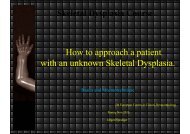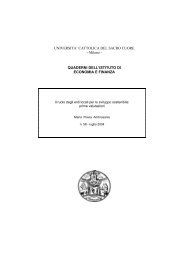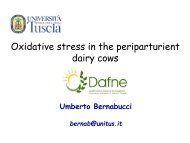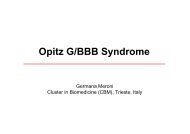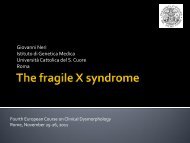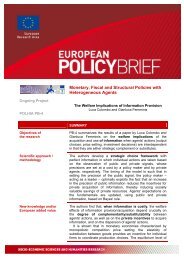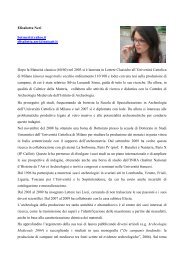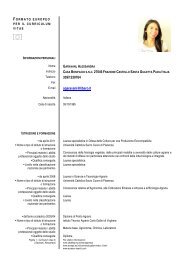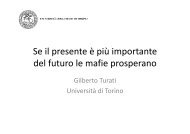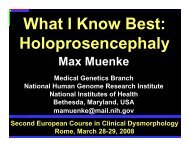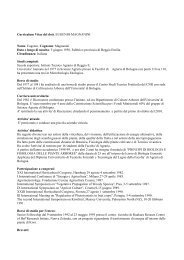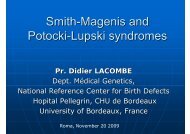I POSSIBILI APPROCCI ALLA VALUTAZIONE DEL ... - Istituti
I POSSIBILI APPROCCI ALLA VALUTAZIONE DEL ... - Istituti
I POSSIBILI APPROCCI ALLA VALUTAZIONE DEL ... - Istituti
You also want an ePaper? Increase the reach of your titles
YUMPU automatically turns print PDFs into web optimized ePapers that Google loves.
La risposta immunitaria a stressori infettivi e noninfettivi<br />
nel suino: distinzione tra la risposta<br />
costitutiva in interferon-alfa rispetto a quella virusindotta<br />
Massimo Amadori, Elisabetta Razzuoli<br />
IZSLER - Brescia<br />
Background<br />
Established view<br />
A new conceptual<br />
framework<br />
Open problems<br />
IZSLER Brescia
Introduzione: l’allevamento del suino<br />
Allevamento suino e uso del farmaco veterinario<br />
Punti critici del ciclo zootecnico: lo svezzamento<br />
Conseguenze fisio-patologiche sugli animali<br />
Possibili strategie per un aumentato benessere e<br />
riduzione dell’uso del farmaco<br />
IZSLER Brescia
L’allevamento del suino in Italia<br />
Suino pesante: 10 milioni capi macellati / anno<br />
Circuiti esterni: 3 milioni capi macellati / anno<br />
Scrofe: 800.000 circa<br />
Suini prodotti: 18 milioni nel complesso<br />
Mancano all’ “appello” 5 milioni di animali !!<br />
Di questi è interessante la scomposizione<br />
IZSLER Brescia
Gli aspetti preoccupanti<br />
(Candotti P., Rota Nodari S., 2006)<br />
Categorie: morti, “scarti” o “declassati”. Quindi:<br />
1,8 milioni morti durante l’allattamento<br />
0,25 milioni di scrofe e verri macellati<br />
0,72 milioni morti entro 80 giorni di vita<br />
0,54 milioni morti nel restante periodo<br />
Rapporto ISTAT 2005: segnalati 800.000 lattoni<br />
e 1.200.000 magroni macellati<br />
2 milioni di suini macellati come “scarti” (11%)<br />
IZSLER Brescia
Motivi di tali perdite ?<br />
Impianti tecnologici avanzati<br />
Riduzione ore lavoro / capo<br />
Strutture “hard”, alta competizione per risorse<br />
e zone riposo<br />
Qualità aria e pavimentazioni<br />
Fasi giovanili: patologie sistemiche (PMWS)<br />
Accrescimento: forme respiratorie<br />
Scrofe: rimonta al 35%, sindromi mammarie,<br />
osteo-articolari<br />
IZSLER Brescia
Uso degli antibiotici<br />
Condizioni attuali: uso di mangimi medicati su<br />
larga scala<br />
Uso profilattico: inaccettabile<br />
Farmaci iniettabili long acting : soggetti < 40<br />
Kg<br />
Soggetti malati: comunque numerosi<br />
Il trattamento di questi è obbligatorio (D.Lvo<br />
146/2001)<br />
IZSLER Brescia
Resistenza agli antibiotici<br />
Parere Scientifico Congiunto 2009 di: ECDC,<br />
EFSA, EMEA, SCENIHR<br />
Antibiotico-resistenza di agenti di zoonosi:<br />
in aumento in tutto il mondo<br />
E’ necessario rafforzare la sorveglianza<br />
Sviluppare nuovi antibiotici<br />
Sviluppare nuove strategie di controllo<br />
della antibiotico-resistenza<br />
(http://www.efsa.europa.eu/cs/BlobServer/Scientific_O<br />
pinion/1372.pdf?ssbinary=true )<br />
IZSLER Brescia
La situazione attuale<br />
Preoccupanti i livelli di resistenza osservati con<br />
Salmonella e Campylobacter spp<br />
Possibile contributo di biocidi (disinfettanti,<br />
antisettici e conservanti)<br />
Livelli diversi nei Paesi UE<br />
Difficile adozione di strategia unitaria<br />
Fonti principali di contagio alimentare: macello<br />
e processazione di alimenti<br />
Precauzioni per fluorochinoloni e cefalosporine<br />
IZSLER Brescia
Ceppi Salmonella resistenti a Chinolonici<br />
IZSLER Brescia
Resistenze agli antibiotici e sanità pubblica:<br />
un’incognita?<br />
The New England Journal of Medicine<br />
342: 1242-1249, 2000<br />
Ceftriaxone-resistent salmonella infection<br />
acquired by a child from cattle<br />
Paul D. Fey et al.<br />
IZSLER Brescia
Fabbisogno di antibiotici: fronti di<br />
intervento<br />
Igiene zootecnica e benessere animale<br />
Tempestività degli accertamenti diagnostici<br />
Genetica animale e adattamento ambientale<br />
(“forbice” da controllare)<br />
Funzionalità del sistema immunitario innato ed<br />
adattativo<br />
Immuno-modulazione mirata in fasi critiche<br />
dei cicli zootecnici<br />
Quali basi concettuali ?<br />
IZSLER Brescia
stimoli<br />
psicosensoriali<br />
SISTEMA NERVOSO CENTRALE<br />
sistema neuroendocrino<br />
SISTEMA IMMUNITARIO<br />
stimoli<br />
antigenici<br />
risposte<br />
comportamentali<br />
risposta<br />
immunitaria<br />
IZSLER Brescia
The stress response<br />
Immune response, stress and inflammation:<br />
ancestral set of responses neutralization of<br />
noxae perturbing body homeostasis<br />
Cytokines : homeostatic agents<br />
Effector mechanisms: similar in infectious and<br />
non-infectious stress<br />
For instance: IL-1 HPA + cerebral NA after<br />
infection, electric shock or restraint<br />
Brain IFN-α after infectious and noninfectious<br />
stimuli<br />
IZSLER Brescia
La risposta immunitaria<br />
Può essere rivolta verso:<br />
STRESSORI INFETTIVI<br />
STRESSORI NON INFETTIVI<br />
Degenerazione, stress e distruzione tissutale<br />
da cause varie (es. : alterazioni e disfunzioni<br />
metaboliche, stress ox, lesioni articolari,<br />
disturbi vascolari, ecc.)<br />
IZSLER Brescia
SISTEMA IMMUNITARIO<br />
Sistema deputato al riconoscimento delle componenti<br />
estranee all’organismo animale<br />
Componenti della “clearance “ degli agenti di infezione<br />
Fase Caratteristiche Meccanismo<br />
Immediata (96 ore)<br />
Non specifica<br />
Inducibile<br />
Non da memoria<br />
Specifica, inducibile, dà<br />
memoria, Comporta<br />
linfociti specifici<br />
Interferon, cellule NK<br />
attivate da IFN<br />
Linfociti T Citotossici,<br />
interferon, anticorpi<br />
specifici<br />
IZSLER Brescia
Attivazione del Sistema Immunitario Innato<br />
1)PAMPs: strutture microbiche tipiche (LPS)<br />
Riconoscimento mediato da: PRP (es. TLR),<br />
RIG-like helicases (RIG-1 e MDA-5 per ac.<br />
Nucleici virali), NLRs (es. per PG batterico)<br />
2) DAMPS: da cellule danneggiate (es. acido<br />
urico) segnalazione del “pericolo”<br />
Quale teoria alla base del modello ?<br />
IZSLER Brescia
An innate sense of danger<br />
(Matzinger P., 2002, Ann. N.Y. Acad. Sci. 961, 341-342)<br />
Il paradigma “self – not self” è insufficiente<br />
Presenza fisiologica di cellule T e B autoreattive<br />
ma innocue, proteine del latte, Ag<br />
alimentari, batteri commensali, feti, sperma:<br />
fenomeni non spiegati dal paradigma<br />
Driving force: riconoscimento del “pericolo”<br />
Danger: stress e/o distruzione tissutale:<br />
rilascio di segnali (alarmine o DAMPs)<br />
IZSLER Brescia
Il ruolo delle “alarmine”<br />
DAMPs o “alarmine”: prodotto di cellule<br />
necrotiche, stressate e degenerate<br />
Alarmine: HMGB1 (e istoni in generale): lega<br />
TLR2 e 4, RAGE<br />
ROS ciclofillina A, proteine S100 (A8, A9):<br />
legame a TLR-4<br />
Trasduzione di potenti segnali in senso proflogistico:<br />
SAPK cJun NH2, p38 MAPK<br />
HSP72: antagonista naturale di tali risposte<br />
(vedi bovine da latte !)<br />
IZSLER Brescia
Alarmine: secrezione di istoni in cellule BHK-21<br />
infettate da FMDV O1 Losanna<br />
1 2 3 4 5 6 7 8<br />
30’ k30 120’ k120’ 240’ k240’ 360 k360’<br />
IZSLER Brescia
Infiammazione mortale, no infezione.<br />
Il mistero SIRS<br />
(Systemic Inflammatory Response Syndrome)<br />
Esempio: pazienti con gamba rotta, dopo 2 giorni<br />
febbre altissima, shock, resp. artificiale<br />
Ipotesi trad. Ridotto flusso ematico all’intestino,<br />
aumento permeab. Intestinale, batteriemia<br />
In realtà: quadro plasmatico sterile in vena porta<br />
Plasma: alto contenuto di DNA, MITOCONDRI !<br />
Per SII: mitocondri = Batteri = risposta flogistica<br />
HBS (Hemorragic Bowel Syndrome) nelle bovine da<br />
latte ??<br />
IZSLER Brescia
Organizzazione della risposta flogistica:<br />
il ruolo dell’inflammosoma<br />
Indotto da segnali di PAMPs e DAMPs<br />
Complesso di oligomeri NLRs/adattatore (ASC)<br />
caspasi 1 IL-1β<br />
3 classi: Nalp1, Nalp3, IPAF (diverso effettore)<br />
IL-1β MyD88: trasduzione di segnale come<br />
PAMP !!<br />
Attivazione: variazioni ioniche (K+), ATP, acido<br />
urico, stress ox<br />
IZSLER Brescia
Ruolo degli inflammosomi<br />
Discriminare l’ambiente microbico e non<br />
microbico per individuare le condizioni di<br />
“pericolo” (Danger Theory)<br />
Repertano segnali infiammatori endogeni in<br />
assenza di infezioni microbiche (vedi SIRS!)<br />
Sono alla base dell’efficacia di alcuni adiuvanti<br />
come Al (OH) 3 DC inflammosoma<br />
NALP3 IL-1β<br />
Collegamento immunità innata / adattativa<br />
IZSLER Brescia
Come si manifesta la risposta a<br />
stressor non-infettivi ?<br />
1) Fenomeno flogistico citochine e chemochine<br />
circuiti regolazione omeostatica<br />
2) Risposta linfocitaria allo stress (specie linf. T γδ):<br />
Riconoscimento di “neo-antigeni” e antigeni da stress:<br />
T10, T22, CD1c (DC!), IPP, ATPseF1, altri Ag MHC-like<br />
(MICA, MICB, H60). Ovvero:<br />
Danno epit. Linf.Tγδ DC risposta T conv.<br />
(inversione del flusso consueto)<br />
Lymphoid Stress-Surveillance Response<br />
IZSLER Brescia
Una nuova frontiera: il concetto di<br />
“Behavioral Immunization”<br />
Precedenti blandi stress sono “educativi”<br />
Fenomeni immunitari implicati ?<br />
Topi deficitari di cellule T fronteggiano peggio lo<br />
stress mentale<br />
Stress: aumentato traffico di linfociti al cervello<br />
Effetto protettivo verso nuovo stress<br />
Minore ansietà dopo vaccinazione con peptide<br />
SNC<br />
IZSLER Brescia
Esistono evidenze in medicina veterinaria?<br />
Lymphoid Stress-Surveillance Response: modelli<br />
umani e murini<br />
Secrezione di citochine in risposta a stressors<br />
non-infettivi: evidenziata anche in bovini e suini<br />
Interferon I (specie IFN-α) gioca un ruolo<br />
regolatorio centrale<br />
IZSLER Brescia
Interferon: a dogma in immunology<br />
Dogmas / paradigms = serendipitous<br />
Discovery of new components of the immune<br />
system<br />
Interferon = no exception to this rule<br />
1957 = Isaacs and Lindenmann discovery of<br />
a potent antiviral substance accumulated in<br />
embryonated eggs<br />
50 years later: most immunologists share the<br />
same view: antiviral activity + “accessory<br />
properties”<br />
IZSLER Brescia
IFNs as homeostatic agents<br />
Three types of IFNs (I, II and III)<br />
Type I IFN: 10 sub-families (α, β, ω, τ, etc.); many α subtypes<br />
IFN-α : a highly diversified system (13 genes and 5 pseudogenes<br />
in humans; at least 14 genes and 2 pseudogenes in pigs) should<br />
serve diverse functions and effector mechanisms<br />
Low levels of IFN α/β in tissues of healthy subjects:<br />
constitutive expression<br />
Steady-state role under health conditions<br />
Most important: frequent involvment in the stress<br />
response<br />
IZSLER Brescia
The physiological IFN response<br />
IFN is produced under health conditions: e.g.<br />
after meals and drinking<br />
Not obligatorily related to infection status<br />
This is true of the whole type I family<br />
IFN-β : maintenance of memory T cells<br />
IFN-τ : survival of the conceptus in ruminants<br />
IZSLER Brescia
Aims of the physiological IFN response<br />
Strong cellular responses to viruses and<br />
cytokines<br />
To control the effects of growth factors<br />
To prevent unnecessary harmful inflammatory<br />
responses in tissues<br />
Default function of IFN-α<br />
It would complement other established<br />
biological activities after infectious and noninfectious<br />
IFN-inducing stimuli<br />
IZSLER Brescia
In vitro activity of IFN-α<br />
Very low concentrations (0.05 – 5 U/ml)<br />
down-regulate CD14 expression in swine<br />
PBMC and PAM, as opposed to higher<br />
concentrations<br />
Signalling by LPS/LPS binding protein is<br />
inhibited<br />
Released CD14: potent scavenging system for<br />
LPS<br />
IZSLER Brescia
How does the control action take place?<br />
A direct modulation of the inflammatory<br />
response in target cells<br />
Release of second messengers for<br />
neighbouring cells<br />
Neighbouring cells would be thus instructed to<br />
down-regulate the inflammatory response<br />
An in vivo propagation of these signals to<br />
distant sites would be possible as well.<br />
IZSLER Brescia
The IFN-α response in farm animals<br />
Low-titered IFN-α response in pigs after early<br />
weaning and transportation (calves, too)<br />
Early weaning: activation of inflammatory<br />
cytokine genes in the small intestine and upregulation<br />
of IFN-γ in PBMC<br />
IFN-α at weaning: (1) A SPF pig model . (2) A<br />
conventional pig model<br />
IZSLER Brescia
The SPF pig study<br />
1 litter of L x Lw SPF piglets (n. 8)<br />
Matched for weight at day 20 of age (4.9±0.9 versus<br />
5.4±0.8 Kg in treatment and control groups, respectively)<br />
and weaned one day later.<br />
At weaning, 4 piglets: 20 IU freeze-dried human IFNalpha<br />
/ Kg b.w. for 10 days in RG lactose per os. 4 piglets:<br />
placebo (the same mass of RG lactose) in a separate cage.<br />
Daily clinical inspections. Blood samples at days –1 / +3 /<br />
+21 with respect to weaning<br />
Individual weight controls at days –1/ +21 / +30<br />
RT real time PCR for inflammatory cytokine genes in<br />
PBMC. Interferon-α and TNF-α bio-assays on serum<br />
samples (MDBK and WEHI 164 cells).<br />
IZSLER Brescia
Results obtained on SPF piglets<br />
No clinical difference between treated and control animals<br />
Daily weight gain greater in IFN alpha-treated groups between days -1<br />
and +21 and also between days 21 and 30; the effect of the treatment between<br />
days –1 and + 30 was almost significant (p
log2(n-fold)<br />
N-fold gene expression values by the 2 -ΔΔCt method<br />
(basis: mean value at day -1)<br />
Housekeeping gene: TATA box-binding protein gene (TBP)<br />
2.0<br />
1.0<br />
0.0<br />
-1.0<br />
-2.0<br />
-3.0<br />
-4.0<br />
-5.0<br />
-hIFN-alpha<br />
IFNA<br />
+hIFN-alpha<br />
-hIFN-alpha<br />
+hIFN-alpha<br />
-hIFN-alpha<br />
IFNG IL1B IL6<br />
TNF<br />
+hIFN-alpha<br />
α<br />
-hIFN-alpha<br />
β<br />
+hIFN-alpha<br />
b<br />
-hIFN-alpha<br />
a<br />
+hIFN-alpha<br />
3d 21d 3d 21d 3d 21d 3d 21d 3d 21d<br />
-hIFN-alpha<br />
+hIFN-alpha<br />
-hIFN-alpha<br />
+hIFN-alpha<br />
-hIFN-alpha<br />
+hIFN-alpha<br />
-hIFN-alpha<br />
+hIFN-alpha<br />
-hIFN-alpha<br />
+hIFN-alpha<br />
IZSLER Brescia
Aims:<br />
The conventional pig model<br />
1) To check the oral, IFN-α treatment under<br />
practical, large-scale conditions (in drinking<br />
water)<br />
2) To evaluate the endogenous IFN-α<br />
response<br />
3) To assess the influence of the weaning age<br />
4) To characterize such a stress-induced<br />
response<br />
IZSLER Brescia
The field trial: role of the endogenous IFN-α response<br />
39, LxLW piglets, of a healthy, farrow-to-finish<br />
herd, randomly allocated to:<br />
Group 1: weaned at 28 days (19 pigs, 2 litters)<br />
Group 2: weaned at 22 days (20 pigs, 2 litters)<br />
Group 3: weaned at 22 days and orally treated<br />
with hIFN-α in drinking water (1 IU / Kg<br />
b.w. over 10 days) (20 piglets, 2 litters).<br />
Clinical checks and blood samplings at days -1 /<br />
+6 / +12 with respect to weaning<br />
IZSLER Brescia
Clinical findings<br />
All piglets remained healthy during the trial<br />
No clinical difference between early and late weaning<br />
groups. DMWG: greater in the late weaning group<br />
(28 days) and in IFN-treated animals (both: +1.5<br />
Kg on average at 48 days of age) (p
The IFN-α response in serum samples<br />
Interferon alpha-positive<br />
alpha positive pigs out of the total<br />
Groups Day -1 Day + 6 Day + 12<br />
1 (weaned at 28 days) 1/19 7/19* 0/19<br />
2 (weaned at 22 days) 1/20 20/20 1/20<br />
3 (weaned at 22 days<br />
and IFN alphatreated)<br />
0/20 18/20 0/20<br />
*Significantly different, p
Gel-filtration<br />
Gel filtration on a Sephadex G-75 75 column of IFN-α IFN in samples<br />
from group 2 pigs at day + 6<br />
Kav<br />
0,8<br />
0,7<br />
0,6<br />
0,5<br />
0,4<br />
0,3<br />
0,2<br />
0,1<br />
Fractions checked by a bioassay<br />
on MDBK cells<br />
Serum<br />
* Also shown by rec. IFN-α 1<br />
0<br />
y = -0,5959x+3,1898<br />
27-30 27 30 kDa*<br />
17-18 17 18 kDa*<br />
< 14 kDa<br />
(Apparent MW)<br />
R 2 = 0,9909<br />
4,1 4,2 4,3 4,4 4,5 4,6 4,7 4,8 4,9<br />
PM log<br />
Log MW<br />
Fractions checked by ELISA<br />
with mAbs F17 and K9<br />
PBMC NP-40 lysates<br />
Also: 58 kDa (dimer)<br />
and 41 kDa<br />
IZSLER Brescia
Flow Cytometry: Cytometry:<br />
analysis of intracellular IFN-α in<br />
fixed and permeabilized swine PBMC at day +6<br />
IFN-α positive samples out of the total:<br />
• Group 1: 4 / 19 (0.6 – 3.9% positive cells)<br />
• Group 2: 10 / 20 (0.6 – 8.8% positive cells)<br />
IZSLER Brescia
Control<br />
Anti-IFN α mAb<br />
Flow cytometry assay for intracellular porcine IFN-α<br />
in fixed and permeabilized swine PBMC at day +6<br />
2% IFN α−positive cells on average<br />
(0.1 – 0.3% in 2-3 month-old pigs)<br />
IZSLER Brescia
RT real time PCR for IFN-α IFN genes (group group 2 pigs) pigs<br />
Day -1<br />
Campione IFN-α 1 IFN-α 2 IFN-α 3 IFN-α 4 IFN-α 5/6 IFN-α 7/11 IFN-α 8 IFN-α12<br />
25T0 - - - - + - - +<br />
26T0 - - - - + - - +<br />
28T0 - - - - - - - +<br />
29T0 - - - - + - - +<br />
30T0 - - - - + + - +<br />
31T0 + - - - + - - -<br />
32T0 + + - - - + - -<br />
33T0 - - - - + - - -<br />
34T0 + + - - + + - +<br />
Day +6: no expression evidenced<br />
Day +12<br />
Campione IFN-α 1 IFN-α 2 IFN-α 3 IFN-α 4 IFN-α 5/6 IFN-α 7/11 IFN-α 8 IFN-α12<br />
25T+12 + + - - - - - -<br />
26T+12 + + - - - - - -<br />
28T+12 + + - - + - - +<br />
29T+12 - - - + - - -<br />
30T+12 - - - - + - - -<br />
31T+12 - + - - + - - +<br />
32T+12 + + - - - - - -<br />
33T+12 - - - - + - - -<br />
34T+12 + + - - + + - +<br />
Assays carried out according to Cheng G. et al., (2006), Gene 382, 28-38<br />
(No valid results for IFN α 10 gene)<br />
IZSLER Brescia
IFN-α gene expression at days -1, +6, +12<br />
Day -1<br />
Day +12<br />
Day +6<br />
Day +12<br />
Day +12<br />
Day -1<br />
Day +6<br />
Day -1<br />
RT real time PCR for IFN-α 5/6<br />
The test was carried out on<br />
PBMC of the same pig at days –1<br />
/ +6 / +12 with respect to weaning<br />
IZSLER Brescia
Constitutive and virus-induced expression<br />
Previous data on PK-15 cells in vitro:<br />
Virus-induced expression: IFN-α 2/3/4/8/9/10/13<br />
Constitutive expression: IFN-α 1/2/5/6/7/11/12<br />
Truncated Porcine IFN-α genes: IFN-α 1/2/3/11<br />
Genes with N-glycosylation site: IFN-α 7/9/10/11<br />
IZSLER Brescia
Issues raised by the field trial and in vitro tests<br />
Is this pattern of response also applied to<br />
infectious (viral) stressors ?<br />
Are inflammatory cytokines released at<br />
weaning implied in the modulation of type I<br />
IFN system ?<br />
This is the reason why we investigated IFN<br />
genes and proteins in a relevant model of in<br />
vitro cultured swine PBMC from healthy, 70 to<br />
80-day old animals, far away from the<br />
weaning stress.<br />
IZSLER Brescia
In vitro tests<br />
IFN proteins (α nd γ) and IFN-α gene expression<br />
in PBMC cultures of 70/80-day old pigs<br />
Time 0<br />
Unstimulated control<br />
Priming (100 IU/ml IFN-a)<br />
Priming + Paramixovirus (NDV) stimulation<br />
NDV, only<br />
Supernatant collection / RNA extraction after 18<br />
hours of culture<br />
IZSLER Brescia
In vitro results<br />
IFN-α1, α2, α4, α5/6 and α7/11 genes were shown to be<br />
involved in constitutive expression in uncultured PBMC<br />
(Time 0 samples).<br />
Further IFN-α genes were then expressed in culture.<br />
Interestingly, expression was often shown in unstimulated<br />
cultures, as well.<br />
As a result, NDV stimulation often caused only increased<br />
expression compared with unstimulated cultures<br />
Alpha 9 expression: virus-dependent, associated to<br />
protein release<br />
IZSLER Brescia
Un ruolo di IL-1β ?<br />
IL-1β suina ricombinante può indurre in vitro<br />
tracce di IFN-α.<br />
Colture di PBMC e di sangue in toto<br />
Per quanto concerne i geni IFN-α, IL-1β si<br />
comporta come NDV, specie per quanto<br />
concerne il gene α9<br />
La co-presenza di TNF-a modula<br />
l’espressione dei geni IFN-α da parte di IL-<br />
1β<br />
Ruolo di inflammosoma in vivo ?<br />
IZSLER Brescia
A possible explanation of the IFN-α response ?<br />
Weaning<br />
(alarmins)<br />
Intestinal cell damage NLRs<br />
inflammosomes IL-1β<br />
Type I IFN<br />
(Control action)<br />
IL-18<br />
IL-12<br />
Ads. LPS<br />
(Amplification of<br />
antibacterial<br />
immune<br />
response)<br />
(α / β) (control action ?)<br />
IFN-γ: danger ! (Imbalance Th17/Treg in SI?)<br />
Up-regulation of crypt cell response to LPS, downregulation<br />
of repair processes in ECM, increased intestinal<br />
permeability: post-weaning diarrhoea !!<br />
IZSLER Brescia
Response to LPS of intestinal cells<br />
Porcine intestinal epithelial cells: expression<br />
of TLR-4 / MD2 complex (Moue et al., 2008)<br />
Fully competent for a response to LPS (IL-8<br />
for example)<br />
IZSLER Brescia
Which circumstantial evidence ?<br />
IL-12 + IL-18 i.p. diarrhoea in mice<br />
Histologically, lesions in SI similar to those of pigs after<br />
weaning. Effects abrogated in IFN-γ KO mice (Chikano<br />
S. et al., 2000, Gut, 47, 779-786)<br />
IFN-γ increases intestinal epithelial permeability<br />
(Beaurepaire C. et al., 2009)<br />
In piglets, IL-1β gene is up-regulated in most parts of<br />
the intestine after weaning (Pié S. et al., 2004)<br />
In piglets, plasma IL-1β is increased after weaning<br />
(McCracken B. et al. 1995)<br />
In vitro, porcine IL-1β induces IFN-α in leukocyte<br />
cultures.<br />
IZSLER Brescia
Conclusions: (1)<br />
An oral, low-dose IFN-α treatment was shown to<br />
modulate the stress of early weaning<br />
No clinical difference, but DMWG was greater<br />
IFN-γ is the main target of the control action in PBMC<br />
This is justified by precise biological properties of IFN-γ<br />
IFN-α: possible amplification loop of the IL-1β response<br />
TNF-α and IL-6 play instead a minor role in the 1st week<br />
after weaning<br />
A tendency to a control action in the 3rd week after<br />
weaning (correlation with WG data in the field trial !)<br />
IZSLER Brescia
Conclusions: (2)<br />
Endogenous IFN-α is involved in the pigs’<br />
adaptation strategy to weaning<br />
The requirement is probably lesser in 4 -, compared<br />
with 3-week old piglets.<br />
A transcriptional feed-back control on IFN-α is<br />
exerted at day 6 after weaning.<br />
IZSLER Brescia
Take home message<br />
Type I IFNs can act as important homeostatic<br />
agents in the response to environmental stressors<br />
The immune system displays similar responses to<br />
both infectious and non-infectious stressors<br />
IZSLER Brescia
Use of IFN-α in veterinary medicine<br />
Field trials as immunomodulator: IFN<br />
administration and induction of endogenous IFN<br />
Environment is critical: poor efficacy in the<br />
presence of overwhelming infectious pressure<br />
Protocols to be adopted in “problem” herds<br />
and/or in farms with abnormal values of clinical<br />
immunological parameters.<br />
Evidence of reduced immunological competence<br />
IZSLER Brescia
IFN-α trial 1: anamnestic data<br />
In a farrow-to-finish farm with 520 sows, a respiratory form was<br />
observed in 40-day old piglets (20 days after weaning) :<br />
» High morbility: 60%<br />
» Dry cough<br />
» Mortality: 7-12%<br />
» Low-grade anorexia<br />
15% of piglets experienced progressive wasting<br />
Virological tests on affected animals revealed both PRRSV (Eu and<br />
USA) and PCV2<br />
IZSLER Brescia
Protocol<br />
Trial scheme<br />
Oral administration of freeze-dried IFN-α for 15 days after weaning<br />
Product constantly fed (10 IU/Kg bw) by an automatic device through the<br />
drinkers<br />
A more strict control of good farming practices<br />
Controls: initial and final weights of pigs, number of dead and waste pigs,<br />
mean daily weight gain<br />
IZSLER Brescia
Group Pigs<br />
Mean<br />
weight<br />
at 22 days<br />
(Kg)<br />
Results<br />
Mean weight<br />
at 86 days<br />
(Kg)<br />
Daily weight<br />
gain (Kg)<br />
Dead and<br />
waste pigs<br />
(%)<br />
IFN-α treated 280 5.6 37.1 0.48 1.4*<br />
Controls 280 5.6 33.8 0.44 4.9*<br />
*P
IFN-α trial 2<br />
(Candotti P., Rota Nodari S., 2003)<br />
Aim: to evaluate the<br />
clinical efficacy of oral<br />
IFN-α treatment against<br />
a reproductive<br />
syndrome ( abortion,<br />
agalaxia and<br />
periparturient mortality)<br />
IZSLER Brescia
Use of oral IFN-α in an outbreak of reproductive PRRS<br />
In july 2002 a herd of 400 sows was affected<br />
by a typical PRRS outbreak, characterized:<br />
» Early parturition<br />
» Agalaxia<br />
» High mortality of piglets<br />
Oral administration in the farrowing cage,<br />
starting at day 7 before the alleged parturition<br />
date till day 3 after farrowing<br />
IZSLER Brescia
100%<br />
80%<br />
60%<br />
40%<br />
20%<br />
0%<br />
Results: sows<br />
Week 1 Week 2 Week 3 Week 4 Week 5 Week 6 Week 7 Week 8 Week 9<br />
Healthy<br />
Diseased<br />
IZSLER Brescia
100<br />
80<br />
60<br />
40<br />
20<br />
0<br />
Week 1<br />
Week 2<br />
Week 3<br />
Week 4<br />
Results: piglets<br />
Week 5<br />
Week 6<br />
Week 7<br />
Week 8<br />
Week 9<br />
Weaned %<br />
Mortality %<br />
IZSLER Brescia
IFN-α trial 3: reproductive PRRS<br />
(Candotti P., Rota Nodari S., 2003)<br />
In January 2002 a herd of 1100 sows was<br />
affected by reproductive PRRS:<br />
» Enzootic abortion<br />
Oral administration of IFN-α was carried out<br />
on all pregnant sows in the ad libitum food<br />
ration for 15 days in a row<br />
The treatment was repeated 15 days later<br />
IZSLER Brescia
70<br />
60<br />
50<br />
40<br />
30<br />
20<br />
10<br />
0<br />
June<br />
August<br />
October<br />
Results<br />
December<br />
Abortions<br />
February<br />
April<br />
June<br />
August<br />
October<br />
December<br />
IZSLER Brescia
Dose/response curve of IFN-α<br />
Foundation in the dose/response curve<br />
Immune effector functions: bell-shaped curve<br />
Positive/decrease/even reversion (e.g. Ab response<br />
to sheep RBC in mice)<br />
Concept: low dose priming / high dose suppression<br />
Timing and concentration: crucial roles (subtypes?)<br />
At odds with antiviral / anti-proliferative activities:<br />
it increases with increasing IFN-α concentrations<br />
IZSLER Brescia
Homeostatic role of IFN-α:<br />
truck transportation of calves<br />
Long-distance journeys of calves:<br />
Serious sensory dullness<br />
Dehydration (HCT, serum protein, albumin, Hb)<br />
Adrenal response (glucose, urea)<br />
PO 4 increase e Fe decrease<br />
Detection of IFN-α in serum<br />
IZSLER Brescia
Risposta al trasporto: citochine e risposta APP+<br />
concentrazione<br />
40<br />
35<br />
30<br />
25<br />
20<br />
15<br />
10<br />
5<br />
0<br />
in vitelli trasportati dalla Polonia<br />
T-2 T-1 T0 T+4 T+15<br />
tempo<br />
IL-6 (ng/ml)<br />
TNF alfa (ng/ml)<br />
Aptoglobina (mg/dl)<br />
Elevata risposta in IL-6 e TNF-alfa (carattere compensativo) prima e dopo il trasporto<br />
Risposta APP+<br />
Elevata pressione infettante in allevamento di origine<br />
IZSLER Brescia
IFN-alfa IFN alfa e risposta adattativa in vitelli trasportati<br />
7<br />
6<br />
5<br />
4<br />
3<br />
2<br />
1<br />
0<br />
dalla Polonia<br />
T-2 T-1 T0 T+4 T+15<br />
Tempo<br />
IFN-alfa<br />
Negativi<br />
Positivi<br />
Risposta in IFN-alfa in tutti gli animali nel centro di raccolta e dopo il trasporto<br />
Diminuzione a 4 giorni dall’arrivo in Italia<br />
Conferma del suo ruolo adattativo di tale citochina<br />
picco di citochine infiammatorie risposta IFN-alfa<br />
IZSLER Brescia
La filiera ANAFI:<br />
il trasporto dei bovini di breve durata<br />
5 trasporti controllati di torelli Frisoni di 6-12<br />
mesi al Centro Genetico ANAFI di Cremona<br />
(totale 26)<br />
Dicembre 2008, Gennaio 2009, Aprile 2009,<br />
Giugno 2009, Luglio 2009<br />
200 – 300 Km, 3-6 ore*, Torino-Cuneo/Cremona<br />
Sopralluoghi a T-4 (esame clinico ed etologico),<br />
T0 (carico-scarico), T+4, T+15, T+30<br />
Prelievi ematici nelle stesse date<br />
Riprese filmate da T-4 a T+4<br />
IZSLER Brescia
E’ importante la componente climatica nei<br />
trasporti animali ? Suddivisione dei trasporti di<br />
breve durata su base stagionale<br />
Si possono distinguere:<br />
2 trasporti invernali (range: 5,7-13,7 °C; 2,6-<br />
9,4 °C ). Trasporti 1 e 2<br />
1 trasporto in stagione termo-neutrale (range<br />
11,3-16,1 °C) Trasporto 3<br />
2 trasporti estivi (range 23-33 °C, THI 46-<br />
73,5). Trasporti 4-5. Temp. > superiori a<br />
quelle prospettate nel doc. Commissione UE<br />
IZSLER Brescia
Lesioni muscolari, enzima CK plasmatico<br />
900<br />
800<br />
700<br />
600<br />
500<br />
400<br />
300<br />
200<br />
100<br />
0<br />
T-4 T0 T+4 T+15 T+30<br />
CK<br />
giorni dal trasporto<br />
Andamento differente nel trasporto 1 a causa di forti interazioni<br />
agoniste di 2 torelli, mai tenuti in gruppo prima. Elevata<br />
prevalenza di risposte IFN-alfa sino a T+15 !!<br />
Gruppo 1<br />
Gruppo2<br />
Gruppo3<br />
Gruppo4<br />
Gruppo 5<br />
IZSLER Brescia
Risposta negativa (APP-) e positiva di fase acuta<br />
45<br />
40<br />
35<br />
30<br />
25<br />
20<br />
15<br />
10<br />
5<br />
0<br />
Albumina<br />
T-4 T0 T+4 T+15 T+30<br />
giorni dal trasporto<br />
La risposta APP+ nel gruppo 5 è accompagnata da risposta APP-<br />
(ipo-albuminemia) a T+15, come evidenziato nelle bovine da latte<br />
nel periparto. Forte correlazione con la risposta in IFN-alfa !!<br />
Gruppo 1<br />
Gruppo2<br />
Gruppo3<br />
Gruppo4<br />
Gruppo 5<br />
IZSLER Brescia
Citochina IL-6 e risposta di fase acuta<br />
10000<br />
1000<br />
100<br />
10<br />
1<br />
T-4 T0 T+4<br />
giorni dal trasporto<br />
T+15 T+30<br />
Andamento atteso per i trasporti 2 e 5: come atteso, in assenza<br />
di lesioni, RFA dipende da incremento ad alto titolo di IL-6<br />
plasmatica.<br />
IL 6<br />
Gruppo 1<br />
Gruppo2<br />
Gruppo3<br />
Gruppo4<br />
Gruppo 5<br />
IZSLER Brescia
Trasporto breve: conclusioni<br />
Non è possibile considerare l’impatto del trasporto<br />
avulso dal contesto ambientale (origine +<br />
destinazione): strategia adattativa globale.<br />
L’esito finale in termini di sanità e benessere animale<br />
dipende dal complesso di condizioni pre e post<br />
trasporto, oltre che dal trasporto stesso.<br />
2 strategie di adattamento:<br />
A basso impatto infiammatorio (gr. 3): incremento e/o<br />
allungamento delle alterazioni da stress acuto<br />
(cortisolo, NEFA, glucosio, lattato)<br />
Ad alto impatto infiammatorio (gr. 1): da traumi nel<br />
trasporto (CK, APP+, IFN-alfa, NEFA)<br />
<br />
IZSLER Brescia
The “hinge” role of IFN-α<br />
A “hinge” role of IFN-α between innate and<br />
adaptive immunity is widely recognized<br />
PDC IFN-α type and extent of the<br />
adaptive immune response<br />
The concept should now be widened<br />
IFN-α would also promote a balance between<br />
danger and response<br />
A homeostatic control action: the “spring”<br />
mechanism<br />
IZSLER Brescia
The “spring” mechanism of IFN-α<br />
IZSLER Brescia
Flow chart of actions<br />
Start of innate immunity: IFN-α released at<br />
moderate/high concentrations after TLR<br />
recognition of microbes<br />
Later on clearance of microbes decrease<br />
of IFN-α release<br />
Shift to an inflammatory control action based<br />
on the transcriptional control of inflammatory<br />
cytokine genes and PAMP receptors (CD14)<br />
Major tissue damage is avoided<br />
The system gets at a “stand-by” status<br />
IZSLER Brescia
Tuning of the IFN-α response<br />
Tuning of the response of paramount<br />
importance<br />
Detrimental effects because of high therapy<br />
dosage, overexpression in transgenic mice,<br />
genetic defects of regulation even without<br />
infection<br />
This confirms the induction of IFN-α under<br />
health conditions and the need for a strict<br />
control of this response<br />
Excessive concentrations of IFN-α checked by<br />
Ab responses in the host (self /not self ??)<br />
IZSLER Brescia
A note of caution<br />
Several features need to be investigated<br />
4 issues:<br />
which effector cell populations ?<br />
how are they activated ?<br />
how can they sense different<br />
concentrations of IFN-α ?<br />
how do they propagate the signal ?<br />
As many issues for future research !!<br />
IZSLER Brescia
Acknowledgements<br />
Dr. Paolo Candotti, IZSLER, Brescia<br />
Dr. Ivonne Laura Archetti, IZSLER, Brescia<br />
Dr. Barbara Begni, IZSLER, Brescia<br />
Antonio Cristiano<br />
Cinzia Mantovani<br />
Lab technicians, IZSLER<br />
IZSLER Brescia
Thank you for<br />
the attention !<br />
IZSLER Brescia



